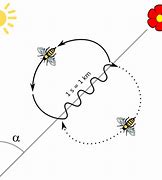Dancing with Bees
October 14, 2022
When a forager honeybee returns to the hive, she is unpacked by worker bees. The enthusiasm displayed when she is greeted and the speed with which she is unpacked gives the forager feedback as to the desirability of whatever it is she found. If she is enthusiastically received, she will likely go back to the exact same spot and return with more. If the reception is lukewarm, she might look for something else.
Once unpacked the forager will proceed to the “dance floor” to perform a dance that describes how far and in what direction whatever she found is located. (I swear I am not making this up.)
If the flower is within 150 feet of the hive, the forager will dance in a circular pattern. Onlookers can smell the floral odor on her and will know to look for that type of flower within 150 feet of the hive. No distance or direction is given - just that it’s near the hive. The more excited the dancer is, the more likely she will get some followers to whatever plant she is describing.
If the flower is more than 150 feet from the hive, the forager will dance in a figure 8 pattern known as the “waggle dance.” (Still not making this up). A waggle dance will describe how far the flower is, and in what direction it can be found. The figure 8 is created by completing two circles made by dancing in opposite directions. The first circle is completed and then the dancer “waggles” her torso and flaps her wings while moving in a straight-line - then reversing direction, she’ll complete another circle. The straight-line part of the waggle dance contains the information the onlookers are waiting for. It gives the distance of the flower as expressed by the duration of the straight-line part of the dance. For example, if the straight-line portion of the waggle dance lasts 1 second, it means the flower is 1kilometer away. If the dance lasts 2 seconds, the flower is 2 kilometers away. (Why am I not surprised that honeybees prefer the metric system?)
Since the predesignated dance floor is just a section of the comb, and the comb hangs down from the top of the hive, the dance floor itself also hangs down vertically – so the direction of the flower is conveyed as the flower’s relationship to the sun. (Like I said, I couldn’t possibly make this up).
If the flower is in the opposite direction of the sun, the straight portion of the waggle dance will be straight up the comb. If the flower is directly in line with the sun, the waggle dance will be straight down the comb. If the flower is 60 degrees to the left of the sun, the dance will be offset 60 degrees to the left of vertical.
To complicate matters further, the interior of the hive is in relative darkness, so the onlookers can only feel the vibration of the dance through the comb and must interpret all the necessary data from that.
I know bees have been doing this for millions of years so far be it from me to tell them how they might streamline this process but the builder in me would like to make a couple suggestions. First, they should build the dance floor just inside the hive opening where there would be enough daylight to see the dance. Secondly, and perhaps more importantly, they should build the dance floor on the horizontal plane so the bees could simply “waggle” in the general direction of the flower. No need for calculating the angle of the waggle dance in relationship to the bee’s gravitational angle and extrapolating from that the flower’s relationship to the azimuth of the sun. They could just point and indicate that the flower is 150 wing beats “that away.” (Okay, that part I did make up.)

